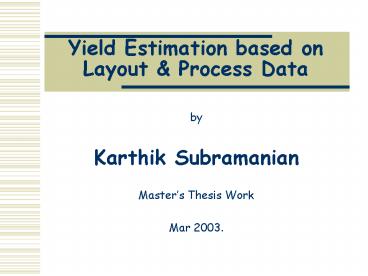Yield Estimation based on Layout - PowerPoint PPT Presentation
1 / 17
Title:
Yield Estimation based on Layout
Description:
Extraction of Critical area using Cadence Dracula. ... Critical Area Extraction Using Dracula. Critical Area in the IC Layout ... – PowerPoint PPT presentation
Number of Views:65
Avg rating:3.0/5.0
Title: Yield Estimation based on Layout
1
Yield Estimation based on Layout Process Data
- by
- Karthik Subramanian
- Masters Thesis Work
- Mar 2003.
2
Contents
- Introduction to yield.
- Concept of critical area in ICs.
- Interconnect yield model.
- Yield estimation at the schematic stage.
- Yield estimation at the layout stage.
- Layout optimization for yield enhancement.
3
Yield in the Semiconductor Industry
- Yield something yielded PRODUCT especially
the amount or quantity produced or returned. - Assessment of the quality of the design.
- Design for manufacturability (DFM).
- Manufacturability measure of the number of
defect-free chips that can be produced from a
single wafer1. - Manufacturability M Nchip Y
Cchip Cwf/(Nchip Y)
4
Why DFM?
- DFM optimization of designs for maximum yield
in the presence of contamination. - (a). High wafer yield through contamination
control has become difficult and hard to achieve.
- (b). Increase in fabless design houses, which
have little control over the manufacturing
process can control costs only by optimizing
designs for higher yield2. - Prediction of the IC area and yield is,
therefore, critical to any sound IC design
methodology.
5
Yield Loss in ICs
- Yield loss occurs when there is an unacceptable
mismatch between the expected and actual
parameters of an IC. - Yield loss in ICs are classified into two types
- (a).Functional yield loss (Yfnc) due to spot
defects (shorts opens). - (b).Parametric yield loss (Ypar) due to global
process disturbances. - Defects circular disks of extra/missing material
in any layer of the IC3.
Total Yield Yfnc Ypar
6
Critical Area in ICs
- The susceptibility of an IC layer to a defect is
captured by the critical area function. - The critical area for a defect of radius rd is
defined as that area on a die where if the center
of a circular defect falls, a fault occurs in the
circuit3.
7
Interconnect Yield Model
- The yield loss primarily takes place in the
metals - (a). The use of the metal layer is more
extensive than that of any other layer in the IC. - (b). The defect count is more in the metal
layer. - Poissons yield model Y exp(-AD)
- A die area D defect density.
- The interconnect yield Y of the chip5
- ACr critical area r0 defect radius r1
half (the min. Spacing between metals) K and p
are model parameters.
8
Yield Estimation at the Schematic Stage
- Approximate value of the yield at the early stage
of the design process. - The Critical area is a function of the structural
attributes of the circuit. - Critical area can be calculated by extracting the
structural parameters from the netlist of the
circuit.
9
Yield Estimation at the Layout Stage
- Layout physical form of the design gives a
realistic value of the yield. - Use of Virtuoso-XL Layout editor to convert the
circuit schematic to its layout, by placing cells
and Autorouting the cells (Virtuoso Custom
Router). - Design of sample layouts using Virtuoso Layout
editor. - Extraction of Critical area using Cadence
Dracula. - Estimation of yield at the layout stage using
the Interconnect yield model.
10
Extraction of Critical Area for Shorts
- Step 1 Expand each geometry shape by radius R.
- Step 2 Find the intersection area of such
expanded geometry. - Step 3 Find the union of all intersection area.
- Step 4 Repeat steps 1, 2, and 3 for a range of
defect sizes6.
11
Extraction of Critical Area for Opens
- Step 1 Shrink both the edges of the conducting
path by radius R extend the left and right edges
of the shrunk conducting path by radius R. - Step 2 Shrink all edges of the rectangular
contact by radius R. - Step 3 Find the union of the shrunk area.
- Step 4 Repeat steps 1, 2, and 3 for a range of
defect sizes4.
12
Critical Area Extraction Using Dracula
13
Critical Area in the IC Layout
14
Yield Dependence on the Critical Area of an IC
15
Script for Yield Estimation at the Layout Stage
16
Yield Enhancement by Layout Optimization
- Design of appropriate cells, that are small in
size. - Choosing smart place and route strategies/optimiza
tion of wire spacing. - (a). Additional Interconnect layers.
- (b). Reducing Cell Utilization.
- (c).Relaxing metal design rules7.
17
References
- 1 Heineken H.T., Khare J., Maly W., Yield
loss Forecasting in the early phases of the VLSI
design process, Custom Integrated Circuits
Conference, Proceedings of the IEEE, 5-8 May
1996, PP.27-30. - 2 Heineken H.T., Khare J., dAbreu.M,
Manufacturability Analysis of Standard Cell
libraries, Custom Integrated Circuits
Conference, Proceedings of the IEEE, 11-14 May
1998, PP.321-324. - 3 Heineken H.T., Maly W., Manufacturability
Analysis Environment MAPEX, Custom Integrated
Circuits Conference, Proceedings of the IEEE, 1-4
May 1994, PP.309-312. - 4 Ouyang C.H., Pleskacz W.A., Maly W.,
Extraction of critical areas for opens in large
VLSI circuits, Defect and Fault Tolerance in
VLSI Systems, 1996 IEEE International Symposium
on, pp.21-29. - 5 Heineken H.T., Maly W., Interconnect Yield
model for Manufacturability prediction in
synthesis of standard cell-based designs,
Computer-Aided Design, 1996, ICCAD-96. Digest of
Technical Papers., 1996 IEEE/ACM International
Conference on , 10-14 Nov 1996 , pp.368 373. - 6 Nag P.K., Maly W., Hierarchical extraction
of critical area for shorts in very large ICs,
Defect and Fault Tolerance in VLSI Systems, 1995,
Proceedings, 1995 IEEE International Workshop on,
pp.19-27. - 7 Ouyang C., Heineken H.T., Khare J., Shaikh
S., d'Abreu M., Maximizing Wafer productivity
through Layout optimizations, VLSI Design, 2000,
Thirteenth International Conference on , 2000 ,
pp. 192 197. - http//www.uta.edu/icdesign/

